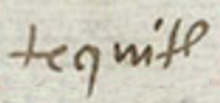tequitl (CST42)
This painting of the simplex glyph for the term tequitl (tributes/taxes) shows a forearm with a left hand extending out toward the viewer’s left. The arm has a red garment with various folds (in a three-dimensional look). In various places in this manuscript, pointing hands indicate the payment of tributes. The companion text explains that 500 pesos in tribute money (in one lump sum) was taken to Mexico City and delivered. The hand seems to be symbolic of delivery or payment. Another example appears on CST19 and CST59. The hand in Plate 55 may also indicate tributes (perhaps both paid and saved). Tributes could be paid in coin and in kind. See the glyph for tlacalaquilli (tributes) from the Telleriano-Remensis, f. 3 recto.
Stephanie Wood
See Kevin Terraciano’s study (Codex Sierra, 2021, pp. 126 and 159) for the transcription of the relevant Nahuatl companion text and the corresponding English translation, and pp. 60–61 for his analysis and examples of hand shown that relate to tribute payments.
Stephanie Wood
1550–1564
Jeff Haskett-Wood
tributos, tasaciones, Ciudad de México, entregar dinero, manosSpanish

tequi(tl), tributes and tribute labor, https://nahuatl.wired-humanities.org/content/tequitl
Códice Sierra-Texupan, plate 42, page dated 1561. Origin: Santa Catalina Texupan, Mixteca Alta, State of Oaxaca. Kevin Terraciano has published an outstanding study of this manuscript (Codex Sierra, 2021), and in his book he refers to alphabetic and “pictorial” writing, not hieroglyphic writing. We are still counting some of the imagery from this source as hieroglyphic writing, but we are also including examples of “iconography” where the images verge on European style illustrations or scenes showing activities. We have this iconography category so that such images can be fruitfully compared with hieroglyphs. Hieroglyphic writing was evolving as a result of the influence of European illustrations, and even alphabetic writing impacted it.
https://bidilaf.buap.mx/objeto.xql?id=48281&busqueda=Texupan&action=search
The Biblioteca Digital Lafragua of the Biblioteca Histórica José María Lafragua in Puebla, Mexico, publishes this Códice Sierra-Texupan, 1550–1564 (62pp., 30.7 x 21.8 cm.), referring to it as being in the “Public Domain.” This image is published here under a Creative Commons license, asking that you cite the Biblioteca Digital Lafragua and this Visual Lexicon of Aztec Hieroglyphs.


